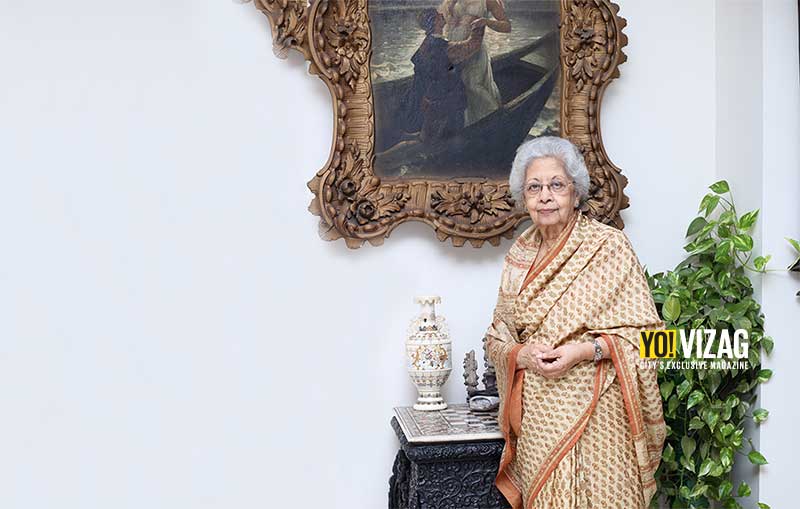The First Activist amongst the Last Aristocrats, meet Ms. Indrani Jagga Row
Hailing from a very well-educated and prosperous family in Bengal; her father was the deputy Accountant General of India during 50s, Ms. Indrani entered into one of the most prominent aristocratic families of North Andhra through her marriage to Mr. AVN Jagga row, the scion of Ankitham family – the large estate holders and zamindar in this part of land. Back then democracy was still at its nascent stage; but for a minuscule minority, vast majority of the people were illiterate and were so naïve that they were not even aware of the rights and privileges of citizens of the new social order that was ushered in during the midnight of 14-15 August, 1947. Having spent her formative years in Tagore’s Santiniketan, she rose to the occasion to ensure the welfare of women and children and helmed many societies and trusts, chief being Indian Red Cross, Women’s conference, Handloom Advisory board, AVN College, and many more. She has witnessed firsthand the growth of Vizag from a small town in early 60s when she first came here, to the present metropolis. And when asked to reminisce about Vizag, she became a personification of nostalgia.
If establishment of Shipyard in Vizag marks an important milestone in Vizag’s history in general and economy in particular, then Ankitham family’s role in it is very prominent. It was Ms. Indrani’s father-in-law, Sri AV Bhanoji Row, famous businessman, philanthropist and the then legislator from Vizag, who invited and advised Scindias to start the ship-building yard in Vizag. Later, the Scindia Shipyard was nationalised and rechristened as Hindustan Shipyard. That the Ankitham family has been into stevedoring business for years by then must have played a role in identifying the potential of ship-building business in Vizag Port area.
She says that during that period there used to be a time-keeping facility atop Dolphin’s nose. Every hour, a round used to be fired using guns atop that hill to mark the time from morning till evening. As most of Vizag was restricted to the one-town area then, the sounds must have made up for the lack of a clock-tower in the town.
Though the town was small, she says, there used to be a large population of American and European expatriates residing in Vizag. They were mostly from Caltex Oil Refinery and Coromandel Fertilizers, the multinational corporations, which subsequently were fully Indianised. Waltair Club used to be the famous recreational place for them along with the rich and famous of Vizag. She says that this earliest amalgamation with rainbow culture might be the reason for the seeming ease, with which Vizag has metamorphosed into a cosmopolitan city.
She has fond memories about the bungalow in which they lived in the beginning. Presently, Dolphin Hotel stands in that place. By the time she came to live in that bungalow, the astronomical observatory, which her husband’s great grand-father and grand-father had established in those precincts had been dismantled. But even the dismantled pieces had her awestruck. She subsequently donated all those remnants to the Visakha Museum. The gardens that surrounded the bungalow were later converted into a residential area, the Dabagardens; and it was the first real-estate layout, created for the benefit of burgeoning middle-class way back in 60s and 70s.
As far as the changing political class is concerned, she says, with nostalgia, that the politicians in the past were great gentlemen with supreme erudition and educational achievements. As an example, she says that though Sri AV Bhanoji Row garu and Sri Tenneti Viswanatham – both highly educated and wonderful legislators – were political opponents, they always had great respect and admiration towards each other. She says, today, such atmosphere is almost absent.
As far as recreational aspects were concerned, she says, that there used to be a wonderful, though small, golf course along the beach in the area near Park Hotel – it was earlier known as Sun-n-Sand hotel. As that course did not have any cafeteria, all the families used to bring along picnic baskets and spend their time playing and frolicking in the golf course and golden beach sands. She says that now the increased population has robbed the fun on the beach what with not even a patch of beach sand left stroll to around, let alone play in.
Looking into the wide, long and bizarrely lit cityscape from the terrace in her wonderfully furnished penthouse in Siripuram, she says – with a seeming lump in throat – that the so called progress and development ravaged the city; increased traffic, unwieldy urbanisation, congested areas, denudation of greenery, commercial exploitation, consumerist appetite all have mortified the laidback and simple lifestyle, which was the order of the day during 60s through 80s. I wish the situation changes for the better to soothe the ruffled emotions of these founding patrons of this city of destiny. Amen!










